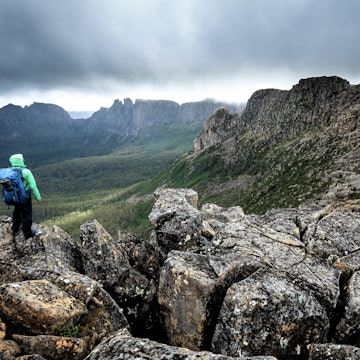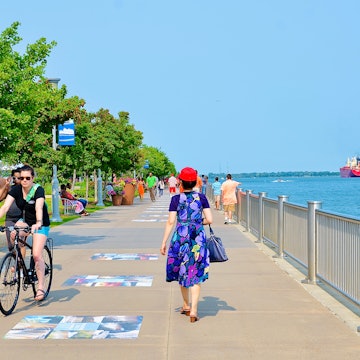
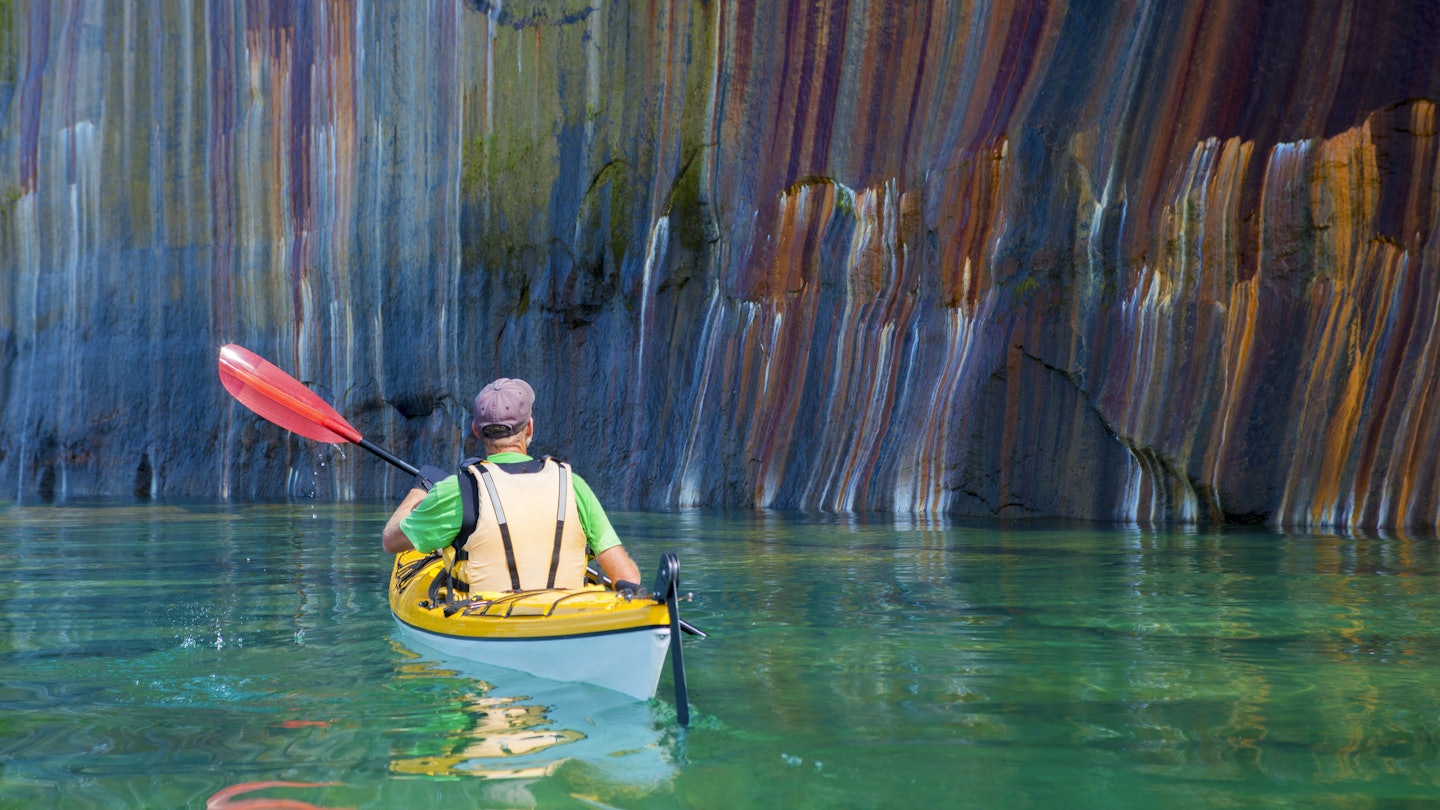
A kayaker viewing the multicolored cliffs at the Pictured Rocks National Lakeshore on Lake Superior in Michigan’s Upper Peninsula. Michael Olson/Getty Images
If you’ve ever met anyone from Michigan’s Lower Peninsula, they likely held up their right hand, then pointed to a spot on their palm to illustrate where they’re from.
But Michigan’s famed “mitten” aside, the Wolverine State has another separate region to the north called the Upper Peninsula. Brimming with wilderness, the sparsely populated “U.P.” is an outdoorsy destination that’s ideal for disconnecting from devices and recreating your favorite childhood summer camp memories.
The Upper Peninsula is big, spanning more than 16,000 sq miles, and most of that is covered with trees. In addition to all the forests, the U.P. is surrounded by three of the Great Lakes (Superior, Huron and Michigan), so it also has roughly 1700 miles of shoreline and beaches to explore. Much of the U.P. is public land — in the form of state parks, national forests, state wildlife management areas, national wildlife refuges or state forests — which means there are basically endless opportunities for adventure here.
Fun fact: The U.P. is part of Michigan because of a clash with neighboring Ohio called the Toledo War. Long story short, while seeking admission to the union in the 1830s, Michigan gave up an area that included Toledo and got the entire Upper Peninsula in return.
Considering a visit to the U.P.? Here’s what to know as you start planning your trip.
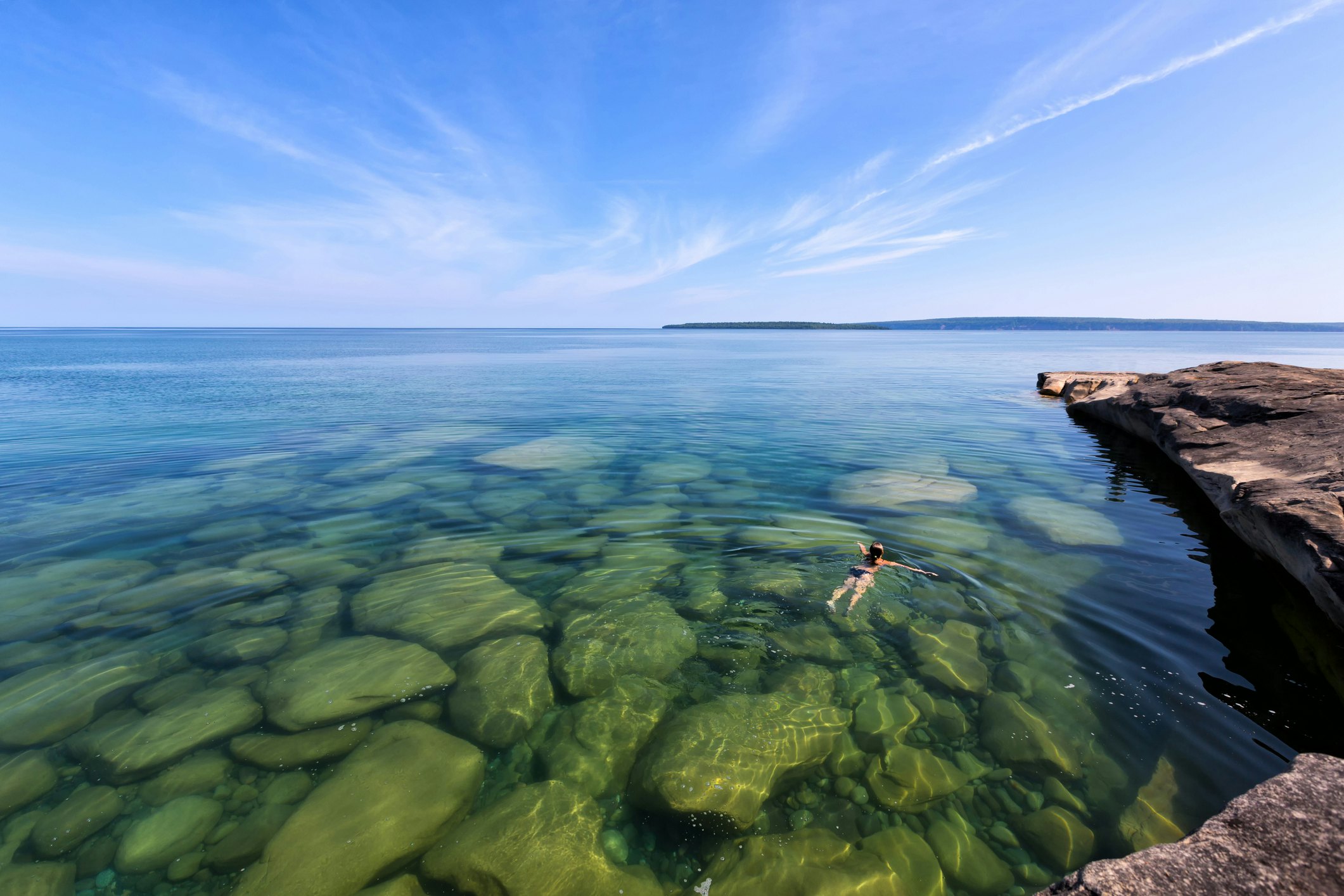
When should I go to the Upper Peninsula of Michigan?
Go in summer for warm weather and outdoor pursuits
Summer is the most popular time to visit the Upper Peninsula, when the weather is warm but not too hot, thanks to breezes coming off the Great Lakes. Most people visit to spend time in nature, which is abundant on the Upper Peninsula, and the mild summer weather is perfect for a wide range of outdoor activities, from camping and hiking to fishing and boating. Be forewarned: mosquitoes and deer flies are out in full force, so bug spray is an absolute must. And, bugs aside, summer is also the U.P.’s busiest time of year, so prepare to rub shoulders with lots of other travelers.

Visit in winter for serene snowscapes and small crowds
That said, winters are also magical in the Upper Peninsula. Temperatures can dip into the single digits, but the some 300,000 people who live in the U.P. don’t just sit around and wait for spring. They gear up and head outside for ice skating, snowmobiling, ice fishing, snowshoeing and cross-country skiing. The U.P. gets lots of snow, thanks to a phenomenon known as the lake effect, so it’s also home to a handful of downhill ski areas.
In addition to warm clothing, bring your camera, as the Upper Peninsula is extremely photogenic in winter. Snow covers the trees like a dusting of powdered sugar, waterfalls freeze into otherworldly shapes and sheets of white-blue ice cover the lakes.
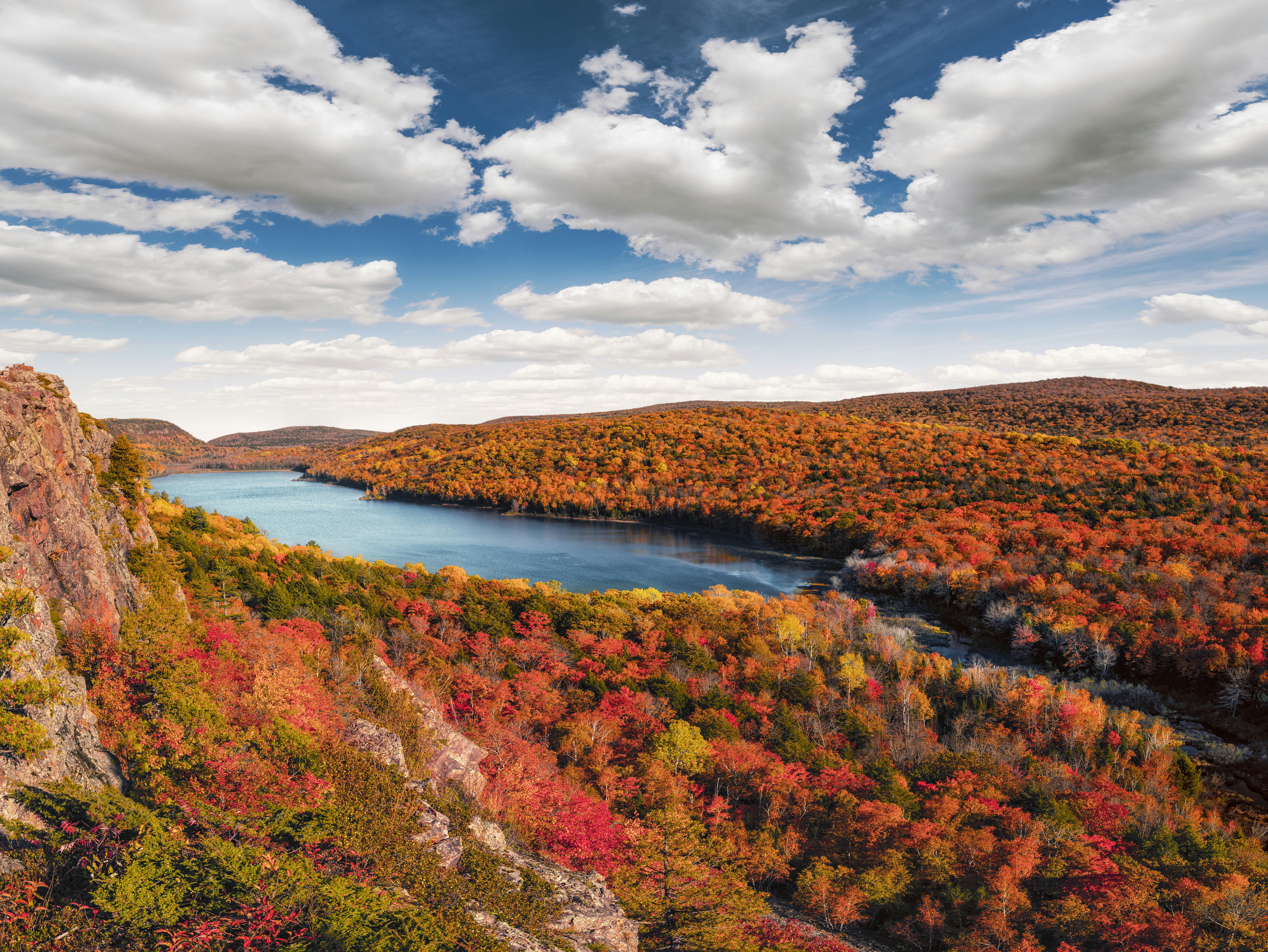
Head to the U.P. in autumn for unbelievably colorful foliage
Fall is equally beautiful in its own way. The Upper Peninsula is brimming with deciduous trees — including sugar maples, red maples, beech, ironwood and yellow birch — which turn varying shades of yellow, orange and red starting in mid- to late-September. One of the best places to go leaf peeping is Lake of the Clouds, a body of water in the Porcupine Mountains (aka “the Porkies”) that’s surrounded by trees of nearly every color. Especially on the weekends during peak fall foliage, the Upper Peninsula can get pretty busy.
How much time should I spend in the Upper Peninsula of Michigan?
The Upper Peninsula is large and fairly difficult to reach, especially if you’re visiting from outside the Midwest. And most people who travel here do so to spend time in nature — there are no big cities in the U.P. So, while you could technically get away with spending a long weekend here, it’s the type of destination that really warrants more time. If you can swing it, consider spending at least a week in the Upper Peninsula.
Is it easy to get in and around the Upper Peninsula of Michigan?
Getting to the Upper Peninsula requires a little extra legwork. The most popular option is driving, though the U.P. does have a few small regional and county airports with flights from Detroit and Chicago. If you opt to fly, you’ll still probably want to rent a car once you arrive. Some of the cities on the Upper Peninsula do have public transit systems, but if you want to explore beyond them — and you almost certainly will — a car is a necessity.
If you’re road-tripping from the Lower Peninsula, you’ll get to cross the famed Mackinac Bridge (pronounced “macki-naw”), which is a worthwhile experience in its own right. The suspension bridge, which opened in 1957, crosses the Straits of Mackinac, which connect Lake Michigan and Lake Huron. It’s a true engineering marvel, spanning roughly 5 miles long and 552ft tall. Some people even call it the “eighth wonder of the world” and, at the moment, it’s the longest suspension bridge in the western hemisphere. From the bridge, you’ll also have stunning views of the waters below.
From Detroit, the drive to the Mackinac Bridge takes a little more than four hours. Once you cross, you’re looking at another two to five hours of driving in the Upper Peninsula, depending on where you’re going.
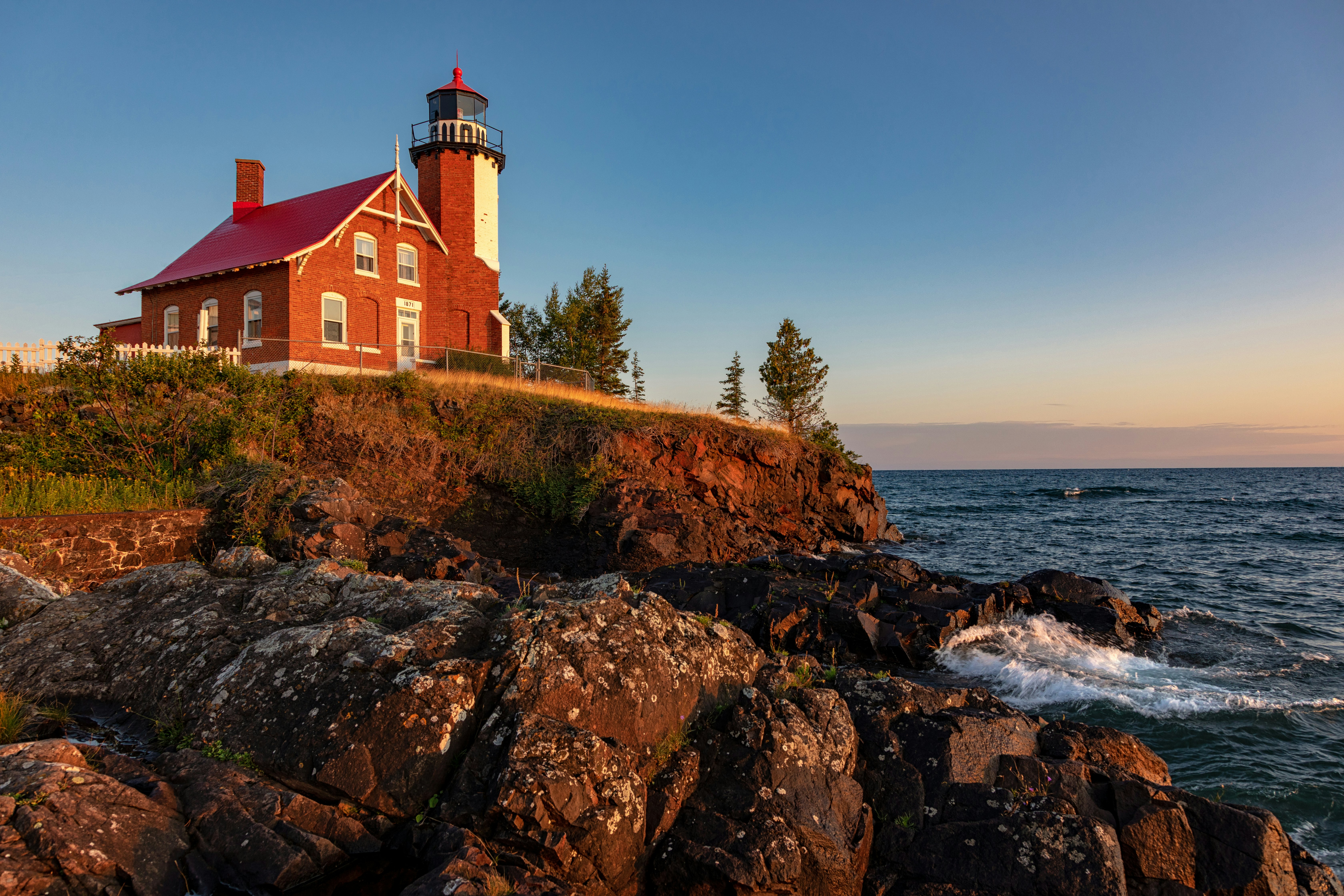
Top things to do in the Upper Peninsula of Michigan
Camp out and watch the sky on the Keweenaw Peninsula
Camp out at one of the 22 state parks in the U.P., then stay up late so you can stargaze. With very little light pollution, the entire Upper Peninsula is ideal for admiring the cosmos. But if you want truly inky-black skies, head to the northern tip of the Keweenaw Peninsula, which received its International Dark Sky Association designation in 2022. In addition to stars, planets, nebulae and meteors, keep your eyes peeled for the northern lights, which are known to make an appearance between August and April.
Snack on a pasty
During the 19th century, Cornish immigrants began moving to the Upper Peninsula to work in the iron and copper mines. For lunch, they usually packed a pasty or two, a semi-circular, hand-held, portable pie filled with meat and vegetables (pronounced like “nasty”). Pasties quickly caught on outside the mines and, today, they remain a beloved Upper Peninsula staple. When you order one, you’ll be asked to choose between gravy or ketchup — try both so you can see which one you prefer.
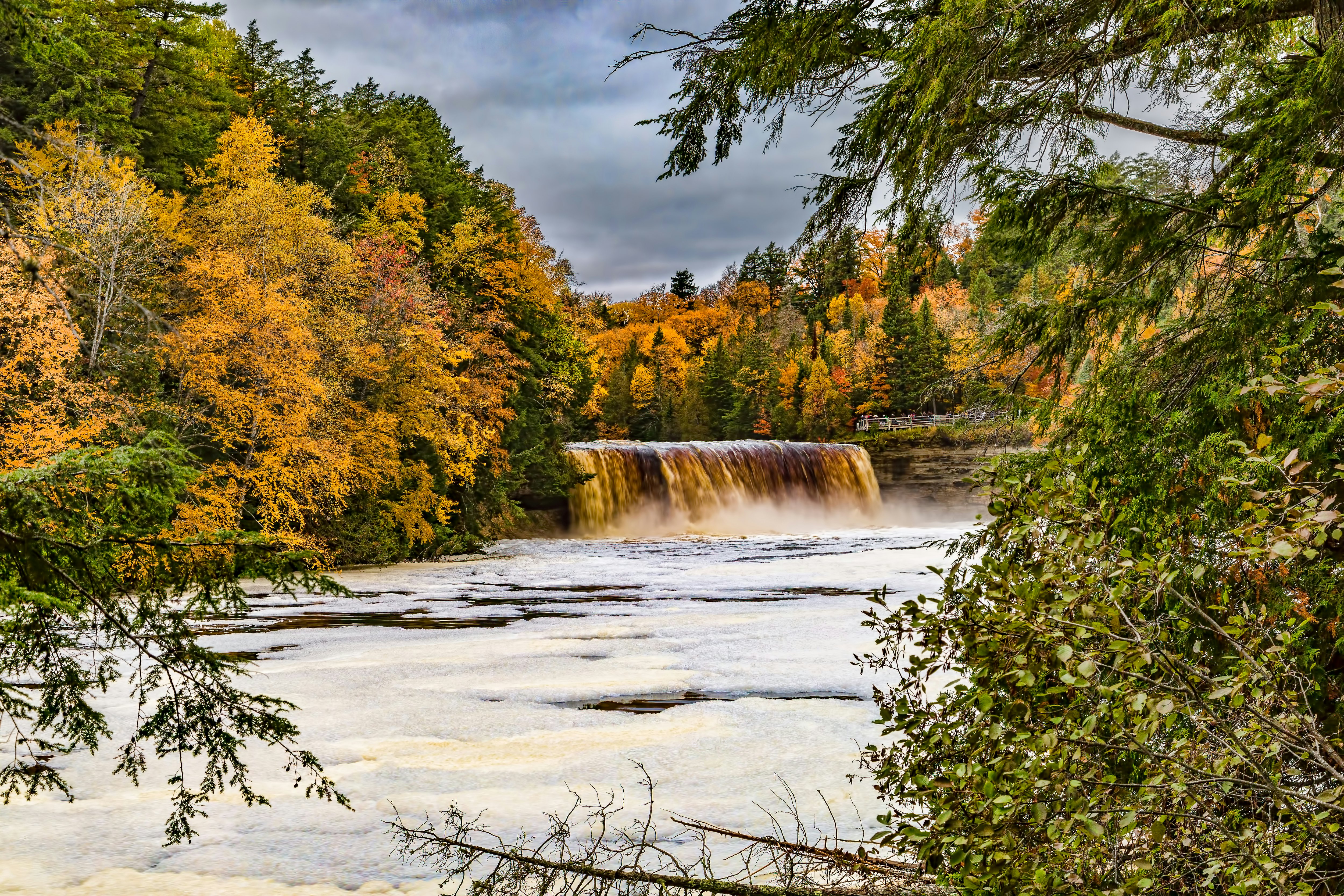
Admire Tahquamenon, or "Root Beer Falls"
You’ve seen one waterfall, you’ve seen them all, right? Wrong. Tahquamenon Falls is not only Michigan’s largest waterfall, but it’s also an unusual color: brown. Yet the water is not murky or muddy. Rather, it’s crystal clear with an amber tint that comes from the tannins in the hemlock, cedar and spruce trees in the swamps of the Tahquamenon River. It’s sometimes referred to as “Root Beer Falls.”
For the best views without much effort, park in the Tahquamenon Upper Falls Parking Lot at Tahquamenon Falls State Park, then walk along the flat, paved trail and boardwalk to the viewing area. On your way back to the car, grab a pint on the patio at Tahquamenon Falls Brewery & Pub.
Paddle along on a water trail
You’ve heard of hiking trails, but what about water trails? These mapped routes make it easy to explore the Upper Peninsula’s many waterways while paddling a canoe or kayak, no experience necessary. The Hiawatha Water Trail, for example, is a 120-mile route on Lake Superior’s southern shore. But, of course, you don’t have to paddle the entire route — you can dip in for as long or as little as you’d like. A particularly scenic section is the stretch that hugs Pictured Rocks National Lakeshore, which features otherworldly, multicolored sandstone cliffs and rock formations. (And if you’re new to paddling or would just prefer the expertise of a guide, there are several approved outfitters who can help you out.)
Sip local wine at tasting rooms
Michigan may not immediately come to mind when you think of US wine regions. But grape-growers in the U.P. have been planting special cold-tolerant varieties that can withstand the region’s bitter temperatures — to great success. Now, the Upper Peninsula has a thriving wine scene, with picturesque tasting rooms at Leigh’s Garden Winery, Northern Sun Winery, Threefold Vine Winery and others.
Watch freighters at the Soo Locks
Whether you’re a maritime buff or not, watching ships navigate the Soo Locks is seriously impressive. Cruise ships, freighters, sailboats, tall ships, you name it — they use the Soo Locks, located on the St Marys River in Sault Ste. Marie (pronounced “soo”), to go between Lake Superior and Lake Huron. From the observation platform at Soo Locks Park, you can watch the locks raise and lower huge vessels using only water and gravity. Head into the visitor center to learn more about how the locks work.

My favorite thing to do in the Upper Peninsula of Michigan
Add Gordon Lightfoot’s haunting ballad "The Wreck of the Edmund Fitzgerald" to your road trip playlist, then blare it on repeat all the way to the Great Lakes Shipwreck Museum. This is not your average museum: it’s a fascinating exploration of the many, many vessels (estimated to be 6000) that sank, disappeared, or crashed while transporting cargo and passengers across the Great Lakes in the 1800s and 1900s.
The museum is situated on the grounds of the Whitefish Point Light Station, which began illuminating the turbulent waters of Lake Superior in 1849. It’s now the oldest operating lighthouse on the lake.
Perhaps more importantly, the museum is located at Whitefish Point, a peninsula that juts out into the water from the northeastern tip of the Upper Peninsula. It marks the eastern end of an 80-mile stretch of coastline that’s been nicknamed the “Shipwreck Coast” because at least 200 major shipwrecks occurred here, including the Edmund Fitzgerland in 1975. (Listen closely, because Whitefish Bay even gets a shoutout in Lightfoot’s song.)
The museum is run by the Great Lakes Shipwreck Historical Society, which is still actively searching for lost or unidentified shipwrecks. Using high-tech gadgets — like side-scan sonar and remotely operated underwater vehicles — it finds a handful of vessels on the lake floor every summer.
Plan to spend an entire day at the museum, because when you’re done with all the exhibits, you can take a walk to the Seney National Wildlife Refuge’s Whitefish Point Unit, which provides critical coastal habitat for the endangered piping plover. Keep your eyes peeled, as these small, tan and white shore birds are great at camouflaging themselves against the rocks and sand.
How much money do I need for the Upper Peninsula of Michigan?
The Upper Peninsula is an affordable place to vacation, especially if you’re camping, hiking and otherwise spending most of your time outdoors. Lodging prices tend to be highest in the summer and fall.
Campsite: $25–35
Basic room for two: $150–250
Self-catering apartment (including Airbnb): $100–200
Coffee: $2.50–3.50
Sandwich: $8–10
Dinner for two: $50
Beer/pint at the bar: $5
What should I pack for the Upper Peninsula of Michigan?
Even during the summer, nights can get pretty chilly in the U.P., so bring a sweatshirt or a lightweight coat if you plan on being outside after dark. And if you are going to build a campfire, buy your firewood once you arrive, as this helps prevent the spread of diseases and insects that can kill trees.









